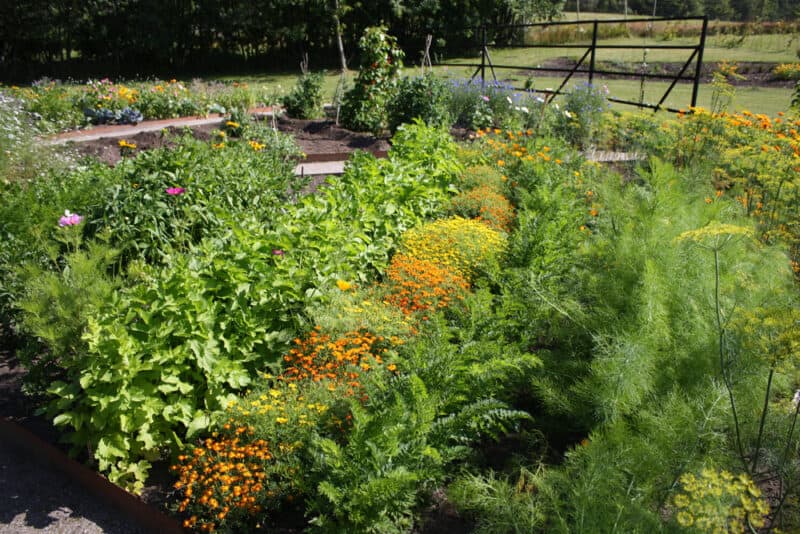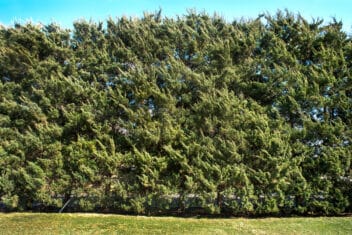It’s always exciting to experiment with new shapes and designs that bring the harmony of nature to their backyard.
Good garden design can emphasize the landscape, improve functionality, and create new ecosystems. But gardens can also be a place for rest and rejuvenation.
Mandala gardens create a space where you can both access your plants, and you can relax while enjoying the unique design.
Here’s everything you need to know about creating a mandala garden.
What Is a Mandala Garden?
A mandala is a geometric design with typically a round shape. The first people to practice mandala drawing were Tibetan Buddhists. Since its invention, it has been adopted by many cultures. Carl Gustav Jung, for instance, believed the mandala shape embodied psychological harmony and used it in his work.
More recently, the mandala has been used to practice improving negative thought processes and soothing anxiety and depression. You’ve most likely come across a coloring book or a tapestry online in the shape of a mandala.

In spiritual terms, the mandala represents an awakening or a source of connection to nature. For many gardeners, this has become a template for their outdoor area.
The geometric patterns of mandalas are known for being good for mental health and encouraging people to relax, so why not make your garden a peaceful retreat in the shape of a mandala?
A mandala garden design is based on the idea of bringing the harmonious elements of the mandala together by creating a geometric pattern out of plants focused on practicality and beauty.
This design is a smart choice in permaculture, allowing you to break up the space with colorful blocks and a systematic organization. The curved shape provides room to walk and access your herbs and veggies.
A mandala garden is typically shaped in a circle pattern, similar to a wheel, with groupings of flowers, colorful plants, and patterns around the space.
Even if you’re not interested in the spiritual aspect of these designs, you can still find some unique inspiration for your garden and create eye-catching patterns.
How To Create a Mandala Garden

The easiest way to start creating a mandala garden is to determine where the paths will be. Take a piece of paper and draw out your circle or half circle. Place another circle in the center. Now, mark out where you want to be able to enter and exit the garden.
You might just have one line down the center of the circle, or maybe you’ll have a path that extends horizontally and vertically. Or, if you have a large garden, you might have even more pathways.
Now, lay out your design in the space you’ll use. You can use spray paint, chalk, or string to outline your new garden. Choose an area with good sun exposure unless you plan on cultivating a shade garden.
Ideally, you won’t make the planting area wider than three feet. The pathways can be as wide or narrow as you want.
Anything wider than three feet makes reaching the plants in the middle difficult. That makes weeding, planting, and harvesting a challenge. Make several layers within the circle rather than one giant space if you have a large area.
The center of your design could have a focal point like a small tree, small pond, obelisk, or arbor if you have enough room. Some people choose to include a bench, fountain, or candle altar where you can meditate or practice yoga.
In the end, you’ll have something that looks like a wheel with several spokes, which are the the walkways, and perhaps several layers. If you did a half circle, it will be more like a rainbow.
Build Your Garden
Before you build, take a day or two to observe the light exposure of your garden. You may realize that a large tree nearby sheds a lot of shade that you hadn’t noticed. You don’t want to go into all the hard work of building raised beds only to find they won’t work.

A mandala garden is essentially a raised garden plot with a circular rather than square design. So, if you’ve never created a raised bed before, familiarize yourself with the process.
You can either build an enclosed bed with wood or metal sides, or simply heap up the soil into a mound without enclosing it. If you have heavy clay or sand, the deeper your beds, the happier your plants will be.
Your walkways can be left natural, with dirt or sod, or you can lay down wood chips or gravel.
What to Plant in a Mandala Garden
After you’ve sectioned off your pathways, you built your garden soil up. Now it’s time to think about what to plant in your mandala garden. Most people stick to fruits, herbs, and veggies, with some flowers mixed in for shape and color and to attract pollinators.
Most people grow vegetables and cane fruits like raspberries, blackberries, and blueberries. Strawberries, tomatoes, gooseberries, or melons could be fun fruit options, too. When it comes to veggies, anything goes.

Cluster a section of leafy plants in one area and a group of brassicas in another. Or plant a bed of peppers and intersperse marigolds to create an alternating pattern. Use squash vines to fill in one area and maybe some zig-zagging rows of chives, parsley, or lavender.
You don’t have to create designs or patterns within the growing area, but if it makes you happy to look out at your unique pattern each time you step outside, go for it.
Benefits of a Mandala Garden

Besides the beautiful aesthetics of a mandala garden, there are also practical reasons for choosing this design for your homestead.
Create Harmony
As we mentioned, mandalas represent harmony and unity. Who doesn’t need more of that in their space?
Gardens are useful for promoting better mental health by engaging people with the outdoors. However, feeling inspired to get into your garden can be hard when you don’t like the space.
Gardening can be great for stress relief. After a long day of working, going outdoors and tending to your plants is a perfect way to unwind. Even better if that space makes you feel balanced and calm.
Easier Maintenance
Another reason that mandala garden designs are also ideal for looking after plants because you include raised beds. You don’t have to bend over as much to water your plants and prune deadhead.
It also allows you to improve the soil quality, which means less worrying about poor drainage or water retention.
It increases the ease of access, as well. You can water your seedlings more easily if there’s a pathway next to a vegetable crop.
Make the Most of the Natural Landscape
The geometric shapes in a mandala garden design make it possible to mimic specific patterns in nature. Instead of having a garden that looks uniform and rigid, you can experiment with various spiral paths and color contrasts.
A Few Mandala Garden Design Ideas
The sky is the limit in creating your mandala garden. You only have to use your imagination. Here are a few ideas to get you started:
Spiral

This mandala design starts with a center circle that spirals out, creating more circles the further you walk away from the middle. People often add pathways cutting the circle to walk between the garden beds, but you could leave it as a spiral.
This encourages walking and contemplation.
Quartered Circle
A quartered circle is just like it sounds. It’s a complete circle broken up by four equidistant rows. You might have just one layer or a dozen, with rows between each circle and four walkways cutting them apart.
Floral Pattern

Do you like growing lots of flowers in your veggie garden? Then, a floral mandala garden is for you.
Choose a few flowers in the same color. For instance: focus on red. Then, fill one section with red flowers. Then, plant a plot of veggies next to it. Next to that, do a different color section.
You can also intersperse clumps of flowers throughout your veggies.
Think of it like coloring with plants.












